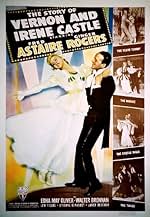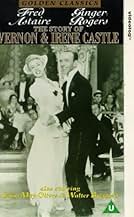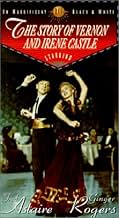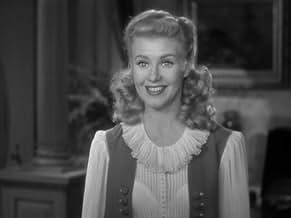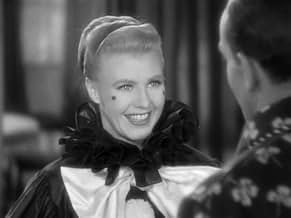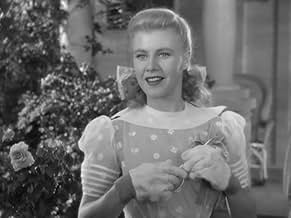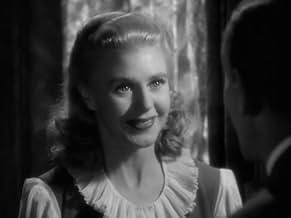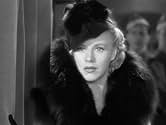IMDb RATING
6.9/10
2.9K
YOUR RATING
The story of the dancing team who taught the world to two-step.The story of the dancing team who taught the world to two-step.The story of the dancing team who taught the world to two-step.
- Awards
- 4 wins & 1 nomination total
Buzz Barton
- Undetermined Secondary Role
- (uncredited)
Max Barwyn
- Waiter - Cafe de Paris
- (uncredited)
Featured reviews
The great irony here is that today, if the professional dancing team of Vernon and Irene Castle is remembered at all, it is because Fred Astaire and Ginger Rogers played them in a movie. Plus,many people don't like "The Story of Vernon and Irene Castle", and just find it lacking something. This is probably because there is virtually no romantic conflict between the two in this film. Astaire & Rogers spend practically the entire film either allied or happily married. Because the two are happily married in the film, you're missing all of the fun of the misunderstandings, squabbling, and sexual tension of their other RKO starring vehicles. The conflict is first economic and professional as the pair struggled to get recognized as great dancers, and then there is World War I in which Vernon Castle, as an English native, feels compelled to enlist. The film is quite good, but it is very sentimental and atypical of Astaire & Rogers' other films. This was intended to be the pair's last film together, and was their last film together at RKO. It was just a series of accidental recasting decisions that led them to reunite in "The Barkleys of Broadway" at MGM ten years later, which was a big splash musical in the big splashy MGM tradition, quite different from their earlier films together.
Here's one of those rare films that I like where there are no villains, just a nice, old-fashioned story with good people.
Of all the Fred Astaire-Ginger Rogers films, I would guess this gets the least amount of publicity and if that's true, it's a shame.
There are plenty of dance scenes in here. I prefer the tap dancing to ballroom, but that's just my personal tastes. The famous dancing duo are great with any style. I like Walter Brennan, so it's nice to see him in this film and it also was nice to see Edna May Oliver play a nice character, for a change.
The only complaint was the ending was so predictable. You see it coming a mile away. How true this story is, I can't say, but overall it's one of my favorite Astaire-Rogers movies. I am sorry it gets so little attention.
Of all the Fred Astaire-Ginger Rogers films, I would guess this gets the least amount of publicity and if that's true, it's a shame.
There are plenty of dance scenes in here. I prefer the tap dancing to ballroom, but that's just my personal tastes. The famous dancing duo are great with any style. I like Walter Brennan, so it's nice to see him in this film and it also was nice to see Edna May Oliver play a nice character, for a change.
The only complaint was the ending was so predictable. You see it coming a mile away. How true this story is, I can't say, but overall it's one of my favorite Astaire-Rogers movies. I am sorry it gets so little attention.
"The Story of Vernon and Irene Castle" was the last of the major Fred Astaire - Ginger Rogers musicals of the 1930s. And it was different in many ways from the others, namely that the story was more important than the songs and dances.
Really, is "Top Hat" with its emphasis on production numbers linked by a thin plot of mistaken identity really a lot different than today's action movies with endless car chases and pyrotechnic special effects linked by a very thin story about a hit man or the earth getting hit by a comet? Sorry about that analogy, I'll take the great musicals over the "actions" any day! "Yo" is not great dialog.
My parents tell me that at the time, this film was panned by the critics and did not make it as big at the box office. Could it be that everyone wanted another "Top Hat" or Swing Time?" I enjoyed those lovely musicals with their big production numbers. Could it be the emphasis on Vernon's patriotic service with the RAF in World War I might have offended many people's "isolationism" in 1939 about the growing World War II?
Fred and Ginger wanted to do a movie with more substance, and they pulled it off in grand style. The songs and dances were nice, with only one very brief "production number." But they did a great job of showing how two young entertainers met, fell in love, became famous, and made a sacrifice in the war. In 1911, young Irene Castle "discovers" Vernon, a second-rate vaudeville comic when she sees him dancing at an evening outing. She shows Vernon her not ready for prime time dance number "The Yama Yama Men." The two fall in love and marry, and with a lot of self-taught dance technique, suddenly hit the big time in France by dancing their famous "Castle Walk." The Castles' fame grew and grew and they toured Europe and America, and made a lot of money through merchandising things like Irene Castle hats. Long before Michael Jordan's basketball shoes. In fact, you will see entries for both Vernon and Irene here in the Movie Database. Irene went on to star in a few silent films, but never made a "talkie." You'll be glad to know that Irene served as an advisor for the Rogers -Astaire film, enhancing its accuracy.
As always, they had some great character actors. I never knew Walter Brennan was ever that young. Fred and Ginger really showed a depth to their acting. From there, of course, Ginger moved into dramatic movies, including her Oscar-winning "Kitty Foyle." I think Fred's later movies matured too.
In short, I think you will like this movie, but don't expect to see a clone of "Swing Time."
Really, is "Top Hat" with its emphasis on production numbers linked by a thin plot of mistaken identity really a lot different than today's action movies with endless car chases and pyrotechnic special effects linked by a very thin story about a hit man or the earth getting hit by a comet? Sorry about that analogy, I'll take the great musicals over the "actions" any day! "Yo" is not great dialog.
My parents tell me that at the time, this film was panned by the critics and did not make it as big at the box office. Could it be that everyone wanted another "Top Hat" or Swing Time?" I enjoyed those lovely musicals with their big production numbers. Could it be the emphasis on Vernon's patriotic service with the RAF in World War I might have offended many people's "isolationism" in 1939 about the growing World War II?
Fred and Ginger wanted to do a movie with more substance, and they pulled it off in grand style. The songs and dances were nice, with only one very brief "production number." But they did a great job of showing how two young entertainers met, fell in love, became famous, and made a sacrifice in the war. In 1911, young Irene Castle "discovers" Vernon, a second-rate vaudeville comic when she sees him dancing at an evening outing. She shows Vernon her not ready for prime time dance number "The Yama Yama Men." The two fall in love and marry, and with a lot of self-taught dance technique, suddenly hit the big time in France by dancing their famous "Castle Walk." The Castles' fame grew and grew and they toured Europe and America, and made a lot of money through merchandising things like Irene Castle hats. Long before Michael Jordan's basketball shoes. In fact, you will see entries for both Vernon and Irene here in the Movie Database. Irene went on to star in a few silent films, but never made a "talkie." You'll be glad to know that Irene served as an advisor for the Rogers -Astaire film, enhancing its accuracy.
As always, they had some great character actors. I never knew Walter Brennan was ever that young. Fred and Ginger really showed a depth to their acting. From there, of course, Ginger moved into dramatic movies, including her Oscar-winning "Kitty Foyle." I think Fred's later movies matured too.
In short, I think you will like this movie, but don't expect to see a clone of "Swing Time."
Do people watch Astaire and Rogers films for more than the pleasure of their dancing and singing? Both performed the dialog parts in their musical comedies well too, but most people think of their movies as a series of opportunities to see great dance numbers and to hear music by Gershwin, Kern, Berlin, Porter, or Youmans. I doubt if they recall the plots.
"Flying Down To Rio" deals with a traveling orchestra that assists in advertising a hotel in Rio De Janairo. Nobody recalls that, but they recall Youmans' melody "Orchids in the Moonlight" and his dance (for Astaire and Rogers) "The Carioca". They also remember the big production number of the young women on the airplane wing ("Ah, Rio, Rio by the Sea - Oh!"). Except for that, few recall the hero is Gene Raymond and the heroine is Delores Del Rio. The running gag of the three agents of the bank that is trying to sabotage the new hotel (and who are only seen as top hatted shadows) may be recalled - but it isn't really worth recalling.
In the later musicals the same problems exist. The story of "Gay Divorcée" (originally "Gay Divorce" on Broadway) is how Rogers hires Eric Rhodes to be found with her at a resort hotel so her husband can have grounds for divorce. The Porter score including "Night and Day" and "The Continental" was good - but who recalls the plot (though Rhodes is very funny as the perpetual hired "other man" for instant divorces. The final irony of the plot (almost like a flat joke's punch line) is that Eric Blore knows a nasty secret about the husband, who (for his own reasons) does not want a divorce.
The series did try to tie the couple down to more than frivolous plots dealing with mistaken identities or fake personalities. FOLLOW THE FLEET and CAREFREE tried to have plots dealing with sailors putting on a show and with a psychologist falling in love with a patient who was engaged to his best friend (Ralph Bellamy, of course). Both were amusing, but rather slapdash. CAREFREE had a curious concluding moment, when a hypnotized Rogers is literally slapped out of her state of hypnosis. Rogers looks like she has been the victim of domestic violence as she is married.
By 1939 Astaire and Rogers were tired of the series, and wanted to go their separate ways. The public was also getting tired of the series. So finally they were given a property that reversed the formula. Instead of the music and dancing ornamenting a bare plot, the plot incorporated the music and dance by telling the story of the greatest ballroom dance team of the first half of the 20th Century, Vernon and Irene Castle.
I have often felt that had Vernon Castle lived beyond 1917 into the period of talkie movies, and stayed married to Irene, they might have been in some of the Astaire Rogers films (the choreography of two rival couples dancing would have been fascinating). Vernon might have played a mentor or rival or father to Fred. But it wasn't to be. As the film shows Vernon (who was English-born) enlisted in the Air Corps in 1917, and was killed in a freak accident saving the life of a pilot he was training (the scene in the film is quite savage in showing the crash).
In the four years (1913 - 1917) when they swept the world with their mastery of dancing, Vernon and Irene Castle became leading celebrities. The film follows the slow steps to fame they took, including getting stuck for awhile in Paris because Vernon was hired only to be a comic actor, not to be a dancer. It shows how Edna Mae Oliver (as their agent and friend) gets them the breaks they deserve, and how they end as figures of social change (ballroom dancing regained popularity, and they did create not only fashions for men and women but also "the Castle Walk" dance step). That this all happened in four years suggests what their impact would have been if they lived into the 1940s together (Irene Castle died in the 1960s).
There are some delightful moments in the film: Ginger Rogers auditioning for her date Fred Astaire by doing "Yama Yama Man" complete with a costume in her parlor. She is imitating the originator of the song, Bessie McCoy. Walter Brennan trying to protect Rogers from Astaire (whose intentions he constantly suspects). Watch him in a small scene watering the grass of the lawn, and ignoring Astaire's questions. Oliver noticing the rhythmic swaying of the overhead lamp in her apartment due to the dancing going on upstairs (where Fred and Ginger are dancing). But what is best is the feeling of impending doom over the couple. We know Vernon is going to die so that means their success and their life together will end soon.
This sense of doom makes "The Story of Vernon and Irene Castle" unique among the Astaire - Rogers films - it is a downer. There is no getting away from the loss of happiness Irene Castle suffered, nor the loss of talent the theater and dance world suffered. The concluding moment of the film always haunted me - Irene and Vernon dancing in spirit together, twirling in a never-ending, eventually disappearing embrace. When I saw the film the first time, Irene Castle was still alive. The second time she was gone but the two stars were still living. Now Fred and Ginger are gone too. That final ghostly dance manages to encompass two sets of dance legends, and increases the sadness that surrounds this - to me - best of their films.
"Flying Down To Rio" deals with a traveling orchestra that assists in advertising a hotel in Rio De Janairo. Nobody recalls that, but they recall Youmans' melody "Orchids in the Moonlight" and his dance (for Astaire and Rogers) "The Carioca". They also remember the big production number of the young women on the airplane wing ("Ah, Rio, Rio by the Sea - Oh!"). Except for that, few recall the hero is Gene Raymond and the heroine is Delores Del Rio. The running gag of the three agents of the bank that is trying to sabotage the new hotel (and who are only seen as top hatted shadows) may be recalled - but it isn't really worth recalling.
In the later musicals the same problems exist. The story of "Gay Divorcée" (originally "Gay Divorce" on Broadway) is how Rogers hires Eric Rhodes to be found with her at a resort hotel so her husband can have grounds for divorce. The Porter score including "Night and Day" and "The Continental" was good - but who recalls the plot (though Rhodes is very funny as the perpetual hired "other man" for instant divorces. The final irony of the plot (almost like a flat joke's punch line) is that Eric Blore knows a nasty secret about the husband, who (for his own reasons) does not want a divorce.
The series did try to tie the couple down to more than frivolous plots dealing with mistaken identities or fake personalities. FOLLOW THE FLEET and CAREFREE tried to have plots dealing with sailors putting on a show and with a psychologist falling in love with a patient who was engaged to his best friend (Ralph Bellamy, of course). Both were amusing, but rather slapdash. CAREFREE had a curious concluding moment, when a hypnotized Rogers is literally slapped out of her state of hypnosis. Rogers looks like she has been the victim of domestic violence as she is married.
By 1939 Astaire and Rogers were tired of the series, and wanted to go their separate ways. The public was also getting tired of the series. So finally they were given a property that reversed the formula. Instead of the music and dancing ornamenting a bare plot, the plot incorporated the music and dance by telling the story of the greatest ballroom dance team of the first half of the 20th Century, Vernon and Irene Castle.
I have often felt that had Vernon Castle lived beyond 1917 into the period of talkie movies, and stayed married to Irene, they might have been in some of the Astaire Rogers films (the choreography of two rival couples dancing would have been fascinating). Vernon might have played a mentor or rival or father to Fred. But it wasn't to be. As the film shows Vernon (who was English-born) enlisted in the Air Corps in 1917, and was killed in a freak accident saving the life of a pilot he was training (the scene in the film is quite savage in showing the crash).
In the four years (1913 - 1917) when they swept the world with their mastery of dancing, Vernon and Irene Castle became leading celebrities. The film follows the slow steps to fame they took, including getting stuck for awhile in Paris because Vernon was hired only to be a comic actor, not to be a dancer. It shows how Edna Mae Oliver (as their agent and friend) gets them the breaks they deserve, and how they end as figures of social change (ballroom dancing regained popularity, and they did create not only fashions for men and women but also "the Castle Walk" dance step). That this all happened in four years suggests what their impact would have been if they lived into the 1940s together (Irene Castle died in the 1960s).
There are some delightful moments in the film: Ginger Rogers auditioning for her date Fred Astaire by doing "Yama Yama Man" complete with a costume in her parlor. She is imitating the originator of the song, Bessie McCoy. Walter Brennan trying to protect Rogers from Astaire (whose intentions he constantly suspects). Watch him in a small scene watering the grass of the lawn, and ignoring Astaire's questions. Oliver noticing the rhythmic swaying of the overhead lamp in her apartment due to the dancing going on upstairs (where Fred and Ginger are dancing). But what is best is the feeling of impending doom over the couple. We know Vernon is going to die so that means their success and their life together will end soon.
This sense of doom makes "The Story of Vernon and Irene Castle" unique among the Astaire - Rogers films - it is a downer. There is no getting away from the loss of happiness Irene Castle suffered, nor the loss of talent the theater and dance world suffered. The concluding moment of the film always haunted me - Irene and Vernon dancing in spirit together, twirling in a never-ending, eventually disappearing embrace. When I saw the film the first time, Irene Castle was still alive. The second time she was gone but the two stars were still living. Now Fred and Ginger are gone too. That final ghostly dance manages to encompass two sets of dance legends, and increases the sadness that surrounds this - to me - best of their films.
"Castles in the Air" is the title of Irene's 1958 autobiography but it's also an apt summarization of this robust, poignant tale. Vernon and Irene Castle were far more famous and influential in their day than Fred Astaire or Ginger Rogers were later, though they are less remembered now.
This movie pays glorious tribute to the Castles and their dance repertoire which Astaire and Rogers beautifully replicate. The crazy maze of fame that swirled around the young couple, their great love for each other and their private travail, are sensitively presented. The supporting cast includes the always superb Walter Brennan as the Castles' chaperone-servant, and Edna May Oliver as their agent, a take-off on real-life Elisabeth (Bessy) Marbury. Producer Lew Fields, who gave Vernon Castle his first job on the New York stage, makes a cameo appearance.
Although Irene Castle served as technical advisor and assisted Walter Plunkett with costuming, there were polite clashes on the set (and off) between her and Ginger Rogers who objected, most notably, to Irene's insistence that she dye her hair dark and cut it short to more accurately resemble her. For those familiar with Irene Castle, whose extraordinary looks (particularly the bobbed hair-style she introduced) were so much a part of her image, they will understand Irene's dissatisfaction with long-tressed, blonde Rogers. It says much for Ginger Rogers' capabilities that the story is not hindered by this departure from authenticity (more glaring then than today).
A NOTE ON COSTUMES:
This film gives some idea of Irene's popularity as a fashion trendsetter which was tremendous in the 1910s and 20s. In fact, many of the stunning gowns Ginger Rogers wears are quite faithful adaptations of costumes designed by Lucile (Lady Duff-Gordon) for Irene Castle during her Broadway and silent-movie days. Ginger's dress with the handkerchief hem and huge chiffon sleeves (double-banded in fur) was copied from the original which Irene wore for the premiere of Irving Berlin's "Watch Your Step" in 1914. This original, by Lucile, is now at the Costume Institute of the Metropolitan Museum of Art. A black and white evening gown, a pleated silk day dress, and a striped travelling suit are other Lucile designs reproduced by Plunkett for Rogers in this picture.
This movie pays glorious tribute to the Castles and their dance repertoire which Astaire and Rogers beautifully replicate. The crazy maze of fame that swirled around the young couple, their great love for each other and their private travail, are sensitively presented. The supporting cast includes the always superb Walter Brennan as the Castles' chaperone-servant, and Edna May Oliver as their agent, a take-off on real-life Elisabeth (Bessy) Marbury. Producer Lew Fields, who gave Vernon Castle his first job on the New York stage, makes a cameo appearance.
Although Irene Castle served as technical advisor and assisted Walter Plunkett with costuming, there were polite clashes on the set (and off) between her and Ginger Rogers who objected, most notably, to Irene's insistence that she dye her hair dark and cut it short to more accurately resemble her. For those familiar with Irene Castle, whose extraordinary looks (particularly the bobbed hair-style she introduced) were so much a part of her image, they will understand Irene's dissatisfaction with long-tressed, blonde Rogers. It says much for Ginger Rogers' capabilities that the story is not hindered by this departure from authenticity (more glaring then than today).
A NOTE ON COSTUMES:
This film gives some idea of Irene's popularity as a fashion trendsetter which was tremendous in the 1910s and 20s. In fact, many of the stunning gowns Ginger Rogers wears are quite faithful adaptations of costumes designed by Lucile (Lady Duff-Gordon) for Irene Castle during her Broadway and silent-movie days. Ginger's dress with the handkerchief hem and huge chiffon sleeves (double-banded in fur) was copied from the original which Irene wore for the premiere of Irving Berlin's "Watch Your Step" in 1914. This original, by Lucile, is now at the Costume Institute of the Metropolitan Museum of Art. A black and white evening gown, a pleated silk day dress, and a striped travelling suit are other Lucile designs reproduced by Plunkett for Rogers in this picture.
Did you know
- TriviaIrene Castle served as a technical advisor on the film. According to Ginger Rogers, Castle disliked every costume she wore and deemed them anachronistic. Due to censorship restrictions, Rogers' costumes evoked late 1930s fashions rather than the more daring styles of Castle's 1910s era. After Rogers refused to bob her hair to portray the hairstyle that Irene had popularized, Castle became more displeased. The studio silenced Castle's protests with an additional payment of $5,000.
- GoofsThe film erroneously depicts the Castles touring with white orchestras. In actuality, Vernon and Irene Castle always toured with a black orchestra; specifically, James Reese Europe's Society Orchestra.
- Quotes
Irene Castle: I thought you could be a first dancer, a very beautiful first dancer because you are a beautiful dancer but you're so smug and conceited that you can't see any further than your funny nose!
- ConnectionsFeatured in Fred Astaire: Puttin' on His Top Hat (1980)
- SoundtracksOnly When You're in My Arms
(1939)
by Con Conrad - Herman Ruby Bert Kalmar
Sung by Fred Astaire (uncredited)
End dance: Fred Astaire (uncredited) and Ginger Rogers (uncredited)
- How long is The Story of Vernon and Irene Castle?Powered by Alexa
Details
- Release date
- Country of origin
- Language
- Also known as
- The Story of Vernon and Irene Castle
- Filming locations
- Production company
- See more company credits at IMDbPro
Box office
- Budget
- $1,196,000 (estimated)
- Runtime1 hour 33 minutes
- Color
- Aspect ratio
- 1.37 : 1
Contribute to this page
Suggest an edit or add missing content


